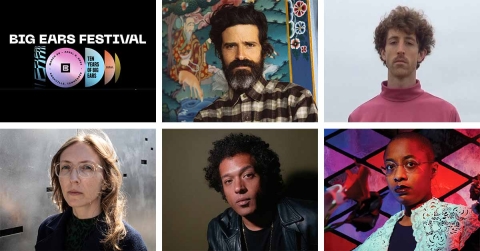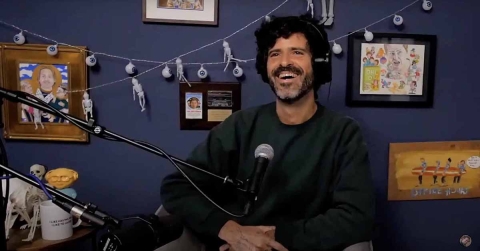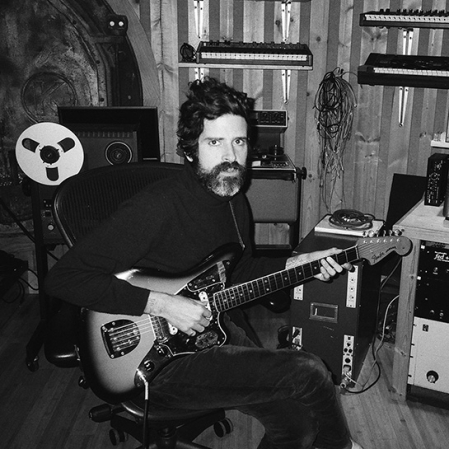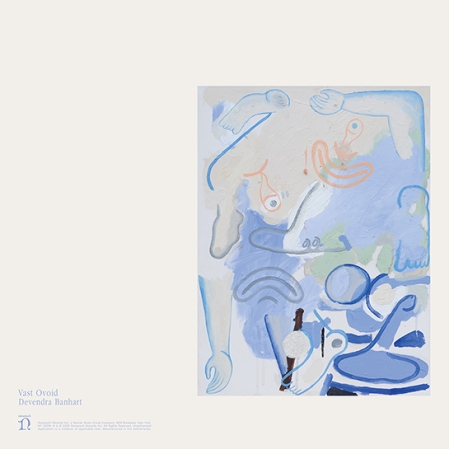Mala, Devendra Banhart's eighth studio album and his Nonesuch debut, took shape in LA, where he and longtime cohort Noah Georgeson produced the album together, playing most of the instruments themselves, using borrowed equipment and a recorder they’d found in a pawn shop. The Guardian says it's a "triumph," giving it four stars, as does Q which calls this "enthralling" album a "career best." The New Yorker calls it a "thought-provoking joy."
Devendra Banhart releases his Nonesuch debut, Mala, on March 12, 2013. The singer/songwriter co-produced the record with his longtime bandmate, guitarist Noah Georgeson.
Mala, Banhart’s eighth studio album, was recorded in his then-home in Los Angeles. He and Georgeson played most of the instruments themselves, using borrowed equipment and a recorder they’d found in a pawn shop. The recorder is a couple of decades' old piece of gear “that a lot of early hip-hop had been made on,” says Banhart. “And knowing my songs are not hip-hop whatsoever, we thought it would be interesting to see how these kinds of songs would sound on equipment that was used to record our favorite rap. Let’s see how this technology would work for us.”
Banhart also notes how his voice has developed over the years: “I don’t really take care of my voice, but, just like with playing guitar, you get more familiar with it, and you get better at it. I’ve always said that I’m very good at not knowing how to play the guitar but, really, it’s just that I’m very comfortable with the utter uncertainty of my approach.”
Banhart’s previous release, 2009’s What Will We Be, received critical acclaim, with Rolling Stone calling it “the best he’s ever made.” The Los Angeles Times said the record “found him making comfortable, laid-back folk that didn’t sound like a compromise—more like an artist growing into his own.”
Devendra Banhart was born in Houston, TX, and moved with his mother to her native Caracas, Venezuela, when his parents separated. The family relocated to Los Angeles during his teenage years; it was there that he learned to speak English, skateboard, and play music. Banhart first began to perform in public while attending the San Francisco Art Institute. He has since lived in Los Angeles, Paris, San Francisco, and New York City.
Banhart first attracted international notice with his 2002 debut album, Oh Me Oh My … The Way the Day Goes By the Sun Is Setting Dogs Are Dreaming Lovesongs of the Christmas Spirit—a collection of recordings he had made for himself. Pitchfork said in its review: “Banhart’s promising debut is the sign of someone destined for great, strange things.” Subsequent albums include Rejoicing in the Hands, Niño Rojo, Cripple Crow, and Smokey Rolls Down Thunder Canyon. He has collaborated with fellow musicians including Antony and the Johnsons, Beck, Vashti Bunyan, Os Mutantes, Swans, and Vetiver. He also has performed with both Gilberto Gil and Caetano Veloso, and was part of a David Byrne–curated concert at Carnegie Hall.
An accomplished visual artist, Banhart’s distinctive, minutely inked, often enigmatic drawings have appeared in galleries all over the world, including the Art Basel Contemporary Art Fair in Miami; the San Francisco Museum of Modern Art; the Palais des Beaux-Arts in Brussels; and Los Angeles’ Museum of Contemporary Art. He has created the cover art for most of his records, including Mala, and in 2010 his artwork and packaging for What Will We Be was nominated for a Grammy.
PRODUCTION CREDITS
All music written by Devendra O. Banhart
except for “Won’t You Come Over,” written by Noah Georgeson and Devendra Banhart
All lyrics written by Devendra Banhart
except for “Loring Baker,” written by Loring Baker
Produced by Noah Georgeson and Devendra Banhart
Recorded by Noah Georgeson, Devendra Banhart and Samur Khouja
Mixed by Noah Georgeson and Devendra Banhart at the Maid’s Room
Mastered by Greg Calbi at Sterling Sound
All artwork by Devendra Banhart
Design and Layout by Ana Kraš and Devendra Banhart
534452
MUSICIANS
Devendra Banhart, guitars (1-4, 6-11, 13-16), vocals (1-6, 8-11, 13-16), textural percussion (1), Wurlitzer (2, 9), drums (3, 4, 11, 15), percussion (4-6), acoustic guitars (5), synthesizer (6, 10, 11), drum machine (6), belt (14), paper (14), bass (15)
Josiah Steinbrick, synth saxophone (1), prepared dulcimer (1), bass (1, 2, 4-6, 9-11, 13, 14), synthesizer (3, 5, 11, 14), synth solo (3, 14), percussion (4), claps (11)
Bram Inscore, cello (1, 5, 8)
Greg Rogoue, drums (1, 2, 9, 14), xylophone (9), chains (14)
Noah Georgeson, guitar (1, 4), programming (1, 3, 4, 6, 9, 10, 13), synthesizer (3, 4, 6, 9-11, 13), drum machine (3, 4, 9), drums (4, 10, 11), percussion (4, 5, 13), string arrangement (5), bass (6), switchblade (14), glass (14), m. concrete (14)
Todd Dahlhoff, bass (3)
Rodrigo Amarante, electric guitar (5), percussion (5)
Ana Kraš, vocals (6)
Bernardo Risquez, vocals (12)
Devendra Risquez, guitars (12), vocals (12)









